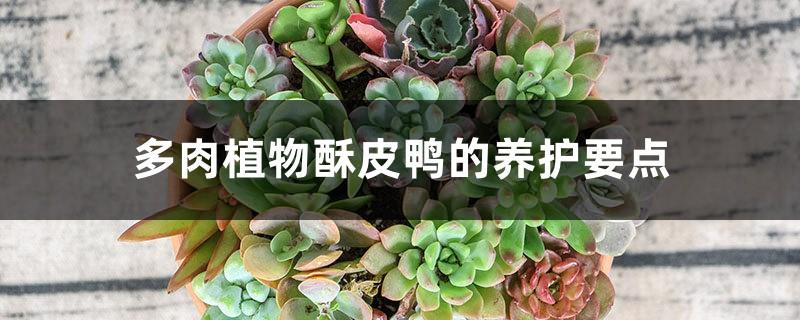Maintenance points of succulent crispy duck
Last Update :2024.11.08
Article Catalog
Echeveria supia is a plant of the genus Echeveria in the Sedum family.

Introduction to crispy duck
Morphological characteristics
The crispy duck plant is an upright succulent shrub that can grow tall. The leaf disk is rosette-shaped, the leaves are broad and ovate, the leaves are smooth and green, the tops and edges of the leaves are red, there are tips, and there is a rib on the back of the leaves that turns red. Flowers bloom in early summer and are cross-pollinated.
Habits
Puffy duck prefers a sunny and cool, dry environment, tolerates semi-shade, is afraid of waterlogging, and avoids hot and humid conditions. It has the habit of growing in cool seasons and dormant in high temperatures in summer. The growth period of the plant is from September every year to June of the next year.

Key points for caring for Crispy Duck h2>
Light
With insufficient light, plants tend to grow leggy, and the distance between leaves will be longer, making the plant shape If it is loose, the stems will become very fragile, while plants grown in sunny places will be short and sturdy, and the leaves will be relatively compact.
Watering
The soil needs to be kept slightly moist during the growth period to avoid water accumulation. Water is cut off in winter, and water will be cut off when the temperature is below 5 degrees Celsius. When the summer temperature exceeds 35°C, the growth of the entire plant basically stops. Watering should be reduced at this time to prevent root rot caused by excessive moisture in the pot soil.
Soil
Cinder mixed with peat and a small amount of perlite, the ratio is about 6:3:1, cultured in small pots.
Temperature
The crispy duck can withstand a low temperature of about minus 2℃ when the pot soil is dry. This is the temperature indoors, not in the open air, no matter how low it is The top growth point of the leaves will suffer from frostbite, dry up or even die. As long as the main trunk does not die, new side branches will re-germinate at the withered place in the next year.
Repotting
It is enough to repot once every 1 to 2 years. Repot before the first watering in early spring.
Propagation
It has branches and can be cut and divided. Branch cutting is very simple. Just remove the healthy old branches, dry them and cut them in slightly moist sandy soil. Roots will basically grow after 15 to 20 days in a cool and ventilated environment. It is best to take cuttings in spring and autumn.
Application
It can be planted in the garden, or potted and placed on the windowsill, coffee table or desk.

- END -
African ice grass cultivation methods and precautions

African icegrass has growth characteristics such as drought resistance, cold resis...
How to grow bergamot potted plants

To raise bergamot potted plants, you need to provide loose and fertile soil. You c...